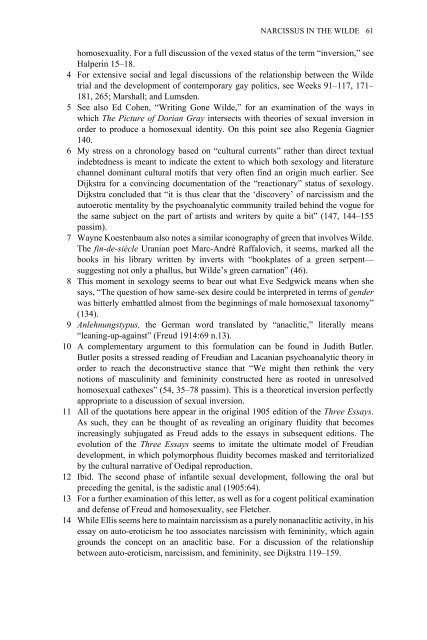Edited by Moe Meyer - Get a Free Blog
Edited by Moe Meyer - Get a Free Blog
Edited by Moe Meyer - Get a Free Blog
You also want an ePaper? Increase the reach of your titles
YUMPU automatically turns print PDFs into web optimized ePapers that Google loves.
NARCISSUS IN THE WILDE 61<br />
homosexuality. For a full discussion of the vexed status of the term “inversion,” see<br />
Halperin 15–18.<br />
4 For extensive social and legal discussions of the relationship between the Wilde<br />
trial and the development of contemporary gay politics, see Weeks 91–117, 171–<br />
181, 265; Marshall; and Lumsden.<br />
5 See also Ed Cohen, “Writing Gone Wilde,” for an examination of the ways in<br />
which The Picture of Dorian Gray intersects with theories of sexual inversion in<br />
order to produce a homosexual identity. On this point see also Regenia Gagnier<br />
140.<br />
6 My stress on a chronology based on “cultural currents” rather than direct textual<br />
indebtedness is meant to indicate the extent to which both sexology and literature<br />
channel dominant cultural motifs that very often find an origin much earlier. See<br />
Dijkstra for a convincing documentation of the “reactionary” status of sexology.<br />
Dijkstra concluded that “it is thus clear that the ‘discovery’ of narcissism and the<br />
autoerotic mentality <strong>by</strong> the psychoanalytic community trailed behind the vogue for<br />
the same subject on the part of artists and writers <strong>by</strong> quite a bit” (147, 144–155<br />
passim).<br />
7 Wayne Koestenbaum also notes a similar iconography of green that involves Wilde.<br />
The fin-de-siècle Uranian poet Marc-André Raffalovich, it seems, marked all the<br />
books in his library written <strong>by</strong> inverts with “bookplates of a green serpent—<br />
suggesting not only a phallus, but Wilde’s green carnation” (46).<br />
8 This moment in sexology seems to bear out what Eve Sedgwick means when she<br />
says, “The question of how same-sex desire could be interpreted in terms of gender<br />
was bitterly embattled almost from the beginnings of male homosexual taxonomy”<br />
(134).<br />
9 Anlehnungstypus, the German word translated <strong>by</strong> “anaclitic,” literally means<br />
“leaning-up-against” (Freud 1914:69 n.13).<br />
10 A complementary argument to this formulation can be found in Judith Butler.<br />
Butler posits a stressed reading of Freudian and Lacanian psychoanalytic theory in<br />
order to reach the deconstructive stance that “We might then rethink the very<br />
notions of masculinity and femininity constructed here as rooted in unresolved<br />
homosexual cathexes” (54, 35–78 passim). This is a theoretical inversion perfectly<br />
appropriate to a discussion of sexual inversion.<br />
11 All of the quotations here appear in the original 1905 edition of the Three Essays.<br />
As such, they can be thought of as revealing an originary fluidity that becomes<br />
increasingly subjugated as Freud adds to the essays in subsequent editions. The<br />
evolution of the Three Essays seems to imitate the ultimate model of Freudian<br />
development, in which polymorphous fluidity becomes masked and territorialized<br />
<strong>by</strong> the cultural narrative of Oedipal reproduction.<br />
12 Ibid. The second phase of infantile sexual development, following the oral but<br />
preceding the genital, is the sadistic anal (1905:64).<br />
13 For a further examination of this letter, as well as for a cogent political examination<br />
and defense of Freud and homosexuality, see Fletcher.<br />
14 While Ellis seems here to maintain narcissism as a purely nonanaclitic activity, in his<br />
essay on auto-eroticism he too associates narcissism with femininity, which again<br />
grounds the concept on an anaclitic base. For a discussion of the relationship<br />
between auto-eroticism, narcissism, and femininity, see Dijkstra 119–159.


